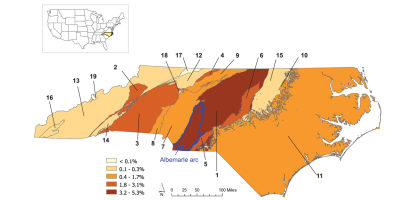Collaborative research shows legacy of ancient volcanoes may help predict arsenic contaminated wells in NC
New findings from UNC Superfund Research Program (SRP) researchers could help local health departments and well users better target well testing and treatment options.
 Many NC well users are at risk of drinking well water contaminated by arsenic from a natural source: the underlying geology. A recent UNC SRP research study took a new approach to identifying where people are most at risk from arsenic-contaminated groundwater. Researchers found that the legacy of volcanoes may be a useful predictor for arsenic in well water. These were the findings of UNC SRP trainee Taylor Alvarado recently published as Geologic predictors of drinking water well contamination in North Carolina in the journal PLOS Water.
Many NC well users are at risk of drinking well water contaminated by arsenic from a natural source: the underlying geology. A recent UNC SRP research study took a new approach to identifying where people are most at risk from arsenic-contaminated groundwater. Researchers found that the legacy of volcanoes may be a useful predictor for arsenic in well water. These were the findings of UNC SRP trainee Taylor Alvarado recently published as Geologic predictors of drinking water well contamination in North Carolina in the journal PLOS Water.
Over 2.4 million North Carolinians get their drinking water from private wells. Unfortunately, recent research has shown that most well users do not regularly test their water for toxic metals, which may put those exposed at a risk for a multitude of health conditions. In North Carolina, one of the most concerning contaminants is inorganic arsenic. Arsenic occurs naturally in the environment and can enter groundwater sources as they flow through and interact with certain geologic formations.

Geologic belts colored by percentage of wells with arsenic concentrations greater than the federal drinking water standard (10 ug/L).
Investigators found that mapping arsenic based on geology revealed different at-risk populations than more traditional mapping by county. Previous mapping of well water contaminants relied on county or other governmental boundaries to predict likely areas of contamination. In this study, researchers used publicly available data from the NCWELL database to map records of well water arsenic contamination by geologic units (underlying rock formations) rather than by county.
Co-author Rob Austin credits the work of UNC SRP’s Dr. Lauren Eaves (a former SRP trainee) in formatting data that allowed well test results to be mapped in this unique way, instead of by county.
“Contaminants don’t care about political boundaries,” says Austin. “Rather, in this case, they are related to materials underlying the earth’s surface.”
For some geologic units, 1 in 3 wells had arsenic exceeding the federal drinking water standard.

Rob Austin, NCSU GIS Information Specialist and UNC SRP Project 4 Investigator
“That’s impacting a lot of people,” Austin continued. “To think about the impact that could have on their lives or their children’s lives underscores the importance and scientific relevance of this work.”
A higher percentage of arsenic-contaminated wells occurred in the Carolina Slate Belt, which runs in North Carolina through the west-central part of the state from Union County to Person County. Especially high concentrations of arsenic were found in the youngest, southwestern portion of the Carolina Slate Belt called the Albemarle Arc.
The highest concentrations of arsenic in well water were found in areas that overlay volcanic rocks. Researchers found that rocks originating from an “ancient volcanic island” are likely sources of arsenic to groundwater. Along with arsenic, these rocks are often associated with gold. The Gold Hill Shear Zone had wells with the 4th highest percentage of arsenic contaminated wells and is also the home of historic Reed Gold Mine.
Within clusters of contaminated wells, researchers still found variability that could depend on underlying fractures or depths of wells. Wells with levels of arsenic that exceeded the federal standard were likely to have more alkaline (higher pH) water.
Austin hopes that this research will help public health officials to work more efficiently in the community.
Even before this publication, this research enabled UNC SRP’s Community Engagement Core to work with health officials in Union County to target areas of the county in need of well water testing. Better targeted public health interventions could lead to improved health of North Carolinians in areas at-risk of well water contamination.
This study was conducted in collaboration with Phillip Bradley from the North Carolina Geologic Survey, as well as researchers from across UNC SRP, including Dr. Owen Duckworth, Rob Austin, Dr. Jason Osborne, and Dr. David Vinson from Project 4; Dr. Mirek Styblo from Project 2; Dr. Kathleen Gray and Dr. Andrew George from the Community Engagement Core; and Dr. Rebecca Fry and Dr. Lauren Eaves from the Administrative Core.
“Working with such an interdisciplinary SRP team afforded me a great opportunity to learn from others and explore subject matter outside my usual silo,” remarked Austin.
Austin credits the leadership and vision of UNC SRP Director Rebecca Fry with ensuring UNC SRP research has a bigger impact to the community.
“A lot of things we do in science don’t always impact people’s day-to-day, their livelihood, or their health,” said Austin. “This was something we were looking at with the goal of helping people.”
